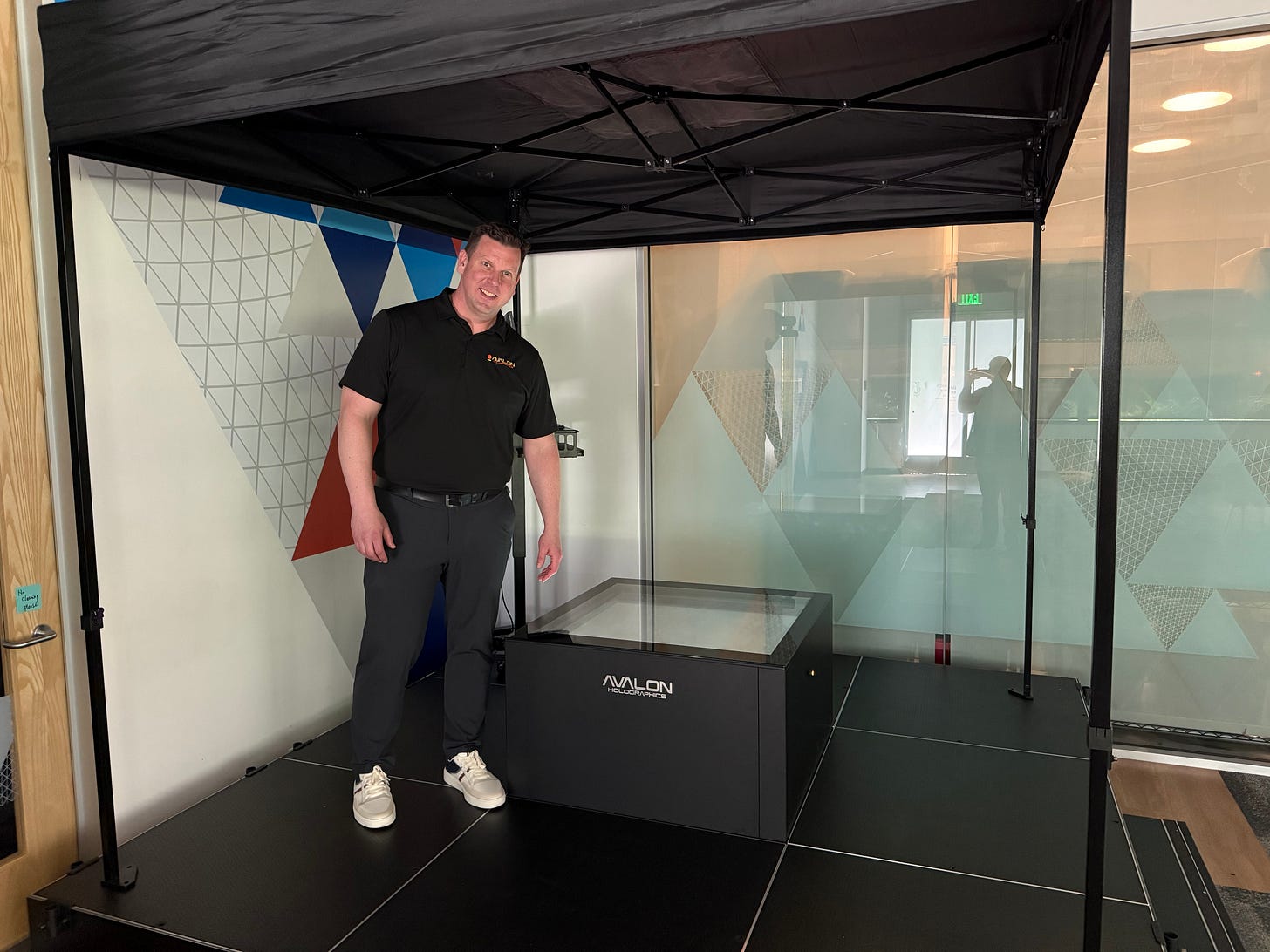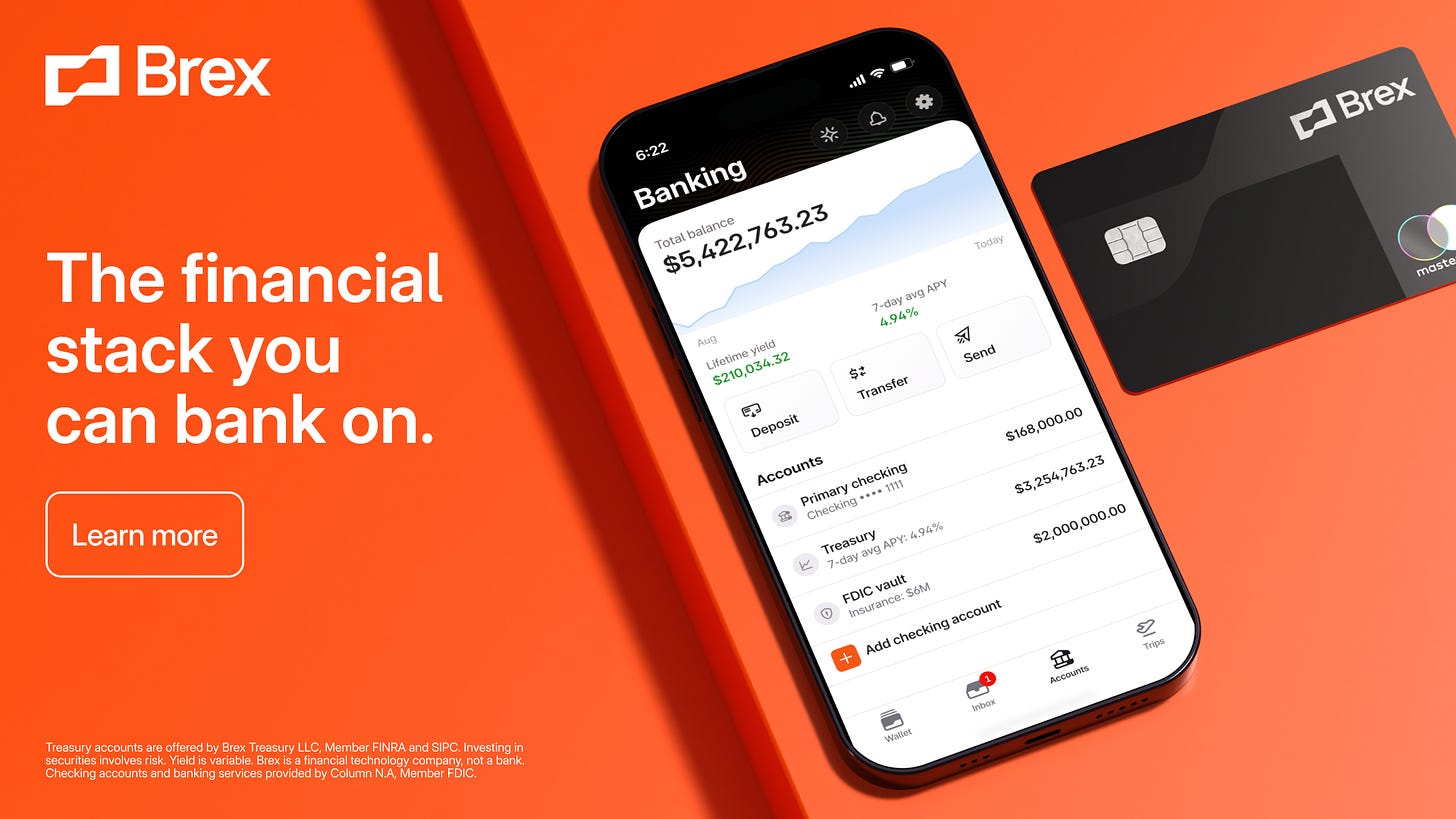The Startup Hoping You'll Try Its $5 Million Hologram
Canadian founder Wally Haas is trying to turn "Iron Man 2" into real life at Avalon, if he can just raise another $50 million or so. Plus: Carta pre-seed data shows a boost for hardware startups.

The Upshot
When Upstarts visited San Francisco to host our first Subscriber Meetup last week, we got an unusual offer: head to a nondescript office to play with a little-known Canadian startup’s $5 million hologram device.
Most of us saw “Iron Man 2” billionaire genius Tony Stark spin around an equally-fictional hologram to devise a new scientific element in and thought, “cool sci-fi,” and moved on. Not entrepreneur Wally Haas. He’s spent the past decade building Avalon Holographics, a Newfoundland-based startup behind the NOVAC table display.
And after spending time with the device and Haas, two things seem apparent to Upstarts: Haas, who is currently seeking another $50 million-plus in funding to build a much cheaper and more powerful version of his tech in tile form, isn’t likely to bring his holograms mainstream, at least anytime soon. But he’s also the kind of product evangelist – a true believer in his own tech – that embodies an Upstart mindset. He won’t slow down if others count him out.
And he’s far from the only founder facing an uphill battle at present. Upstarts got early access to Carta’s “State of Pre-Seed” report for the first quarter, and the numbers tell a tougher story at the earliest stages. Startups raised $737 million in the first three months of the year, Carta found, across 5,119 investment instruments – down about 20% from where the last quarter of 2024 ended up.
But while the number of earliest-stage venture deals dropped, their median valuations went up due to demand in AI, biotech and hardware. “It’s a tale of two cities right now in venture,” says Peter Walker, Carta’s head of insights.
Programming note: It’s all the more timely for Upstarts Media to be hosting its first NY Tech Week event on June 2, alongside partners Company Ventures, Engine and Mercury. I’ll be interviewing local investors Nick Chirls, Jenny Fielding and Matthew Harrigan about Raising Your First Round(table). Early-stage founders (pre-seed and seed) can apply to join us for lunch and an open conversation here.
More on Avalon’s holograms – and the numbers showing longer odds for earliest-stage founders – below.
Presented by our Launch Partner – and recent host of our Subscriber Meetup – Brex.
Building a startup is hard. Managing your finances shouldn’t be. Brex gives you the speed, control, and scale to grow, without slowing you down.
✅ Same-hour access to high-yield banking
✅ Up to 20x higher card limits with bonus rewards
✅ Automated expense processing and invoicing
More than 30,000 companies—including 1 in 3 U.S. startups, such as Anthropic, Substack, Scale AI, and Robinhood—trust Brex to help them spend smarter and move faster. Run your startup on Brex → brex.com/upstarts
Hologram Holdout
Waving his hand through a holographic image of a supersized muffin, Avalon’s Haas jokes his own creation is making him hungry.
We’re going through one of the first demos of his startup’s residency in the Bay Area, and the founder is still working out some kinks. They also are doing their best to manage expectations. A big challenge of building something known through science fiction: they’re going against impossible expectations. Stark could flick and spin his hologram, and Star Trek project star systems in detail.
The NOVAC on which we eventually play a version of Asteroids, moving and firing ships in 3D at approaching rocks, is just the fourth in existence and consisting of millions of dollars’ worth of lasers and sensors – the equivalent of thousands of TVs – suffers from being both unfamiliarly novel and surprisingly ordinary at the same time.

Styled a “commander’s table,” it’s intended for military officers to walk through dangerous tactical missions, or for surgeons to map out a surgery pre-op. In practice, it’s a large-sized box that you can walk around and still see 3D images inside, with two people able to wave their hands through it, or point at the same object.
From a technical standpoint, that’s a huge accomplishment, explains Haas. Most would-be hologram systems, like one that projected Tupac at Coachella in 2012, use reflections and angles to make 2D screens appear with more depth, but only work at fixed angles. Avalon’s holograms use rays of light the way we naturally see them, meaning you don’t need a headache-inducing virtual reality headset or set location for them to be visible.
Today, Avalon’s tech shows a high-resolution depth of about 12 to 15 inches; above or below that, the image looks “foggy” or blurry, but you can still make it out. Avalon doesn’t produce the images itself: a demo of a special forces military operation to quickly surround a building lags as it uses live data from Google Maps. But the Canadian Armed Forces, an early customer, and the U.S. Special Operations Command at Fort Bragg, set to test a pilot in upcoming weeks, would have higher-fidelity stuff.
What they’d gain from using holograms, argues Haas, is an intuitive sense of terrain and its topography you wouldn’t get from a 3D render on a TV screen, plus the ability for different decision-makers to move around the model while keeping the same reference points.
Haas is building the company in St. John’s, the capital of Canadian easternmost province Newfoundland and Labrador, where he previously built and sold his first startup, Avalon Microelectronics, which made optical equipment, for $18 million to then-public company Altera in 2010. Haas had fully vested around the time that Intel announced it was buying Altera in turn in 2015, and decided he wasn’t sticking around.
“I didn’t really meld particularly well with big company culture,” says Haas. Fixated by holograms, he decided to work with a small research team to understand if Stark technology was possible.
By the end of their first year, he felt confident that their design was feasible; Avalon raised a $2.5 million seed round in 2017 and has now raised a total of about $35.7 million in venture funding, with another $30 million or so in contracts, grants and other investment, the company says. Its lead investors are two businessmen tied to Verafin, a St. John’s-based anti-crime software business acquired by Nasdaq for $2.75 billion: Jamie King, Verafin’s former co-founder and CEO; and Mark Dobbin, president at Killick Capital and a former Verafin board director.
The startup shipped the first prototype of its holograms in 2019, with a depth of 4 inches, and eventually signed on with the Canada’s Armed Forces and defense contractors that Haas says he can’t name. The company says it employs 93 people today.
But Avalon has set up shop in the Bay Area, and Haas is touring the globe (he’s in Japan this week) to drum up more investment for Avalon, to the tune of $50 million-plus. Such funding could greatly speed up the startup’s ability to produce hologram-specific chips in a tile format, allowing the NOVAC’s successor to project from a wall, table or floor at a cost of just hundreds of thousands, not millions, and a quality improvement of 10x, Haas says.
“If we had infinite funding from the beginning of this company, it would already be in your home,” says Haas. “This is truly a deep tech company; it’s extremely difficult to do what we’ve done.”

The odds appear stacked against him. One of the most promising startups to raise venture funding for holograms, Austin-based Zebra Imaging, was acquired by a European company in 2017; whether that business is still operating is murky; its named CEO didn’t respond to a comment request. Another European hologram startup with a corresponding crypto coin doesn’t inspire more confidence, and several others listed as having raised millions by Crunchbase no longer appear active.
But with customers, 60 or so patents and another 60 in the works, Haas is hopeful. Unlike software startup Gamma’s CEO, who warned investors not to reach out, Avalon welcomes outreach from risk-taking investors, or at least a demo. The company envisions applications beyond medicine and defense in architecture and design, as well as sports and entertainment. (A diehard Buffalo Bills fan, Haas dreams of watching a live football game via hologram.)
He’ll keep building regardless. “It’s just the start of this long journey, even though it’s taken us 10 years to get here,” says Haas. “I really, really care about bringing this technology to the world.”
The SAFE Play
With a sample set of 50,000 startups and 3,000 venture funds contributing anonymized data through their deal activity, Carta’s quarterly data reports get a zoomed-out view of the wider startup ecosystem’s earliest-stage funding.
Those deals often take the form of convertible notes, a loan that converts into equity; or a SAFE, a simple agreement for future equity that gives an investor the right to equity in the startup’s next funding round, without interest.
According to Walker at Carta, SAFEs continue to gain popularity as the instrument of choice for most startups across the U.S., with convertible notes used more by hardware and biotech companies with immediate capital needs.
Such businesses, and crypto startups with more complex token economics, showed an uptick in activity earlier this year, he says, despite that data mostly coming in before the Trump administration’s tariffs pushed more attention to manufacturing and hardware domestically.
“There’s more openness these days to fund real-world products, especially at the early stages,” Walker says.
AI still dominates the high end of the market, but Q2 data will prove an interesting test case for how much investors poured money into high-demand areas like it versus paused activity due to market turbulence. Carta’s data team typically has seen a whip-like motion in which growth-stage investments react to interest rate changes or other market forces first, and early-stage startup investing feels an impact a few months later.
“I will be really interested to see if Q2 funding data comes in much lower than people expect, because the uncertainty was holding people back from doing deals,” he adds.
One wrinkle for hardware businesses – even at the larger-size like Avalon – is that convertible notes or loans do come at a higher price when interest rates are higher. “It’s really about the maturity date” of any loans, Walker adds. “That demands a conversation between founders and investors.”





A) I LOVE this kind of tech. Anything that makes this world feel like the sci-fi books I grew up reading - I’m in! B) I think the challenge for this startup will be whether they find enough use cases for it. Whether it is pre-op debrief or some topographical review - screens can do it today in 2D for much cheaper and they do not require a bespoke table installation.